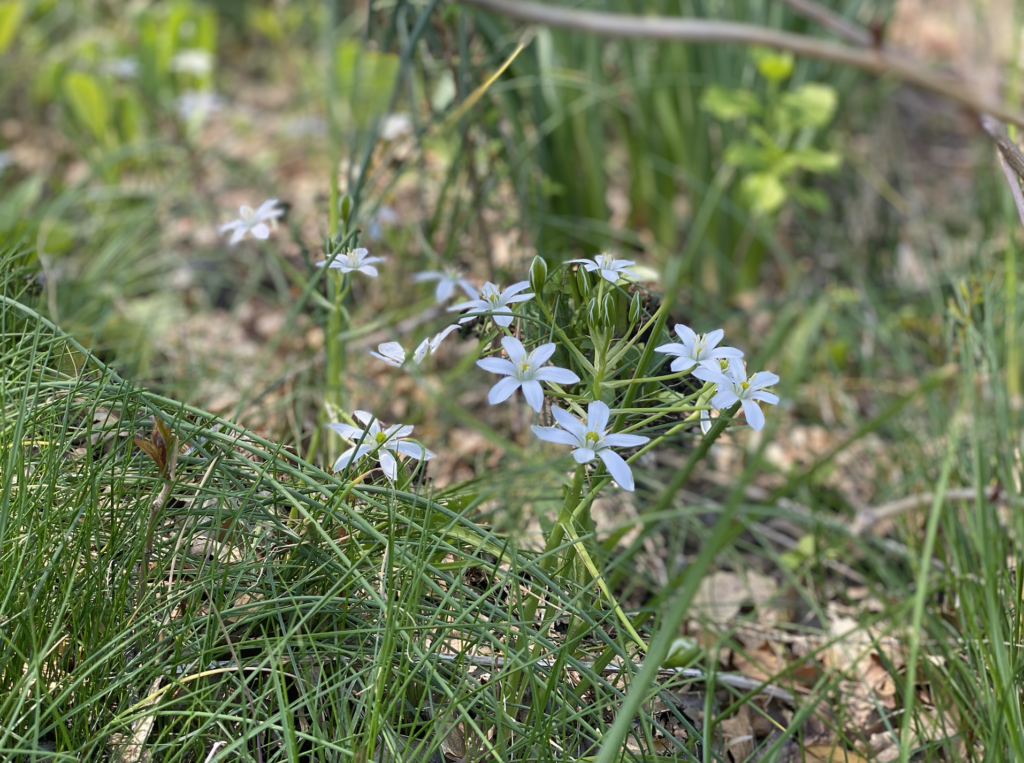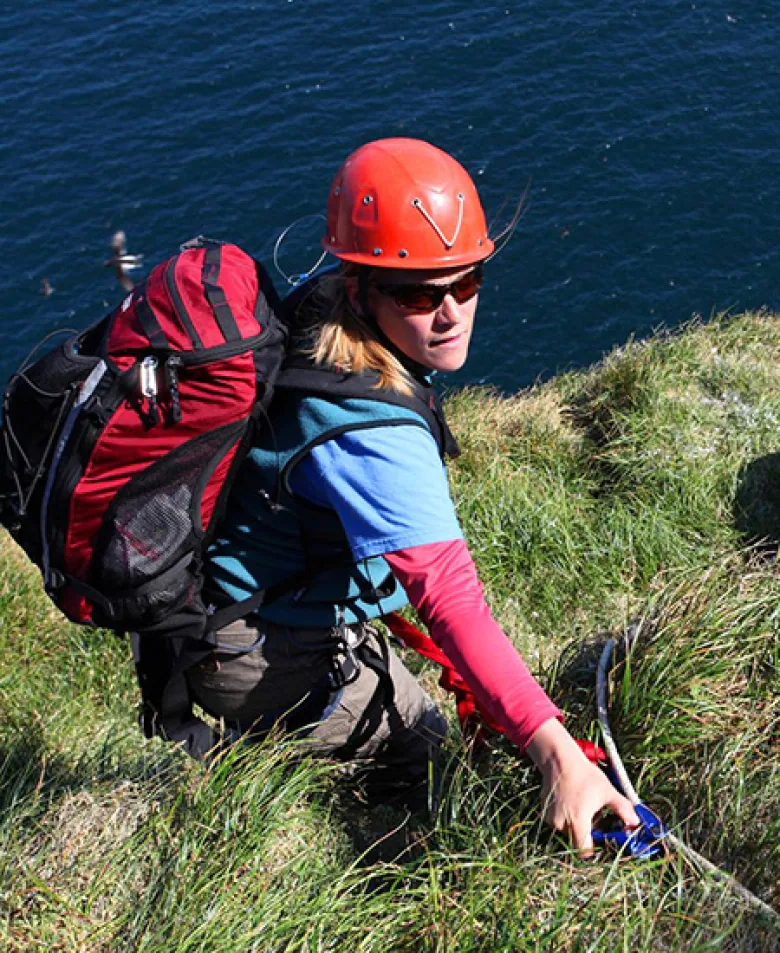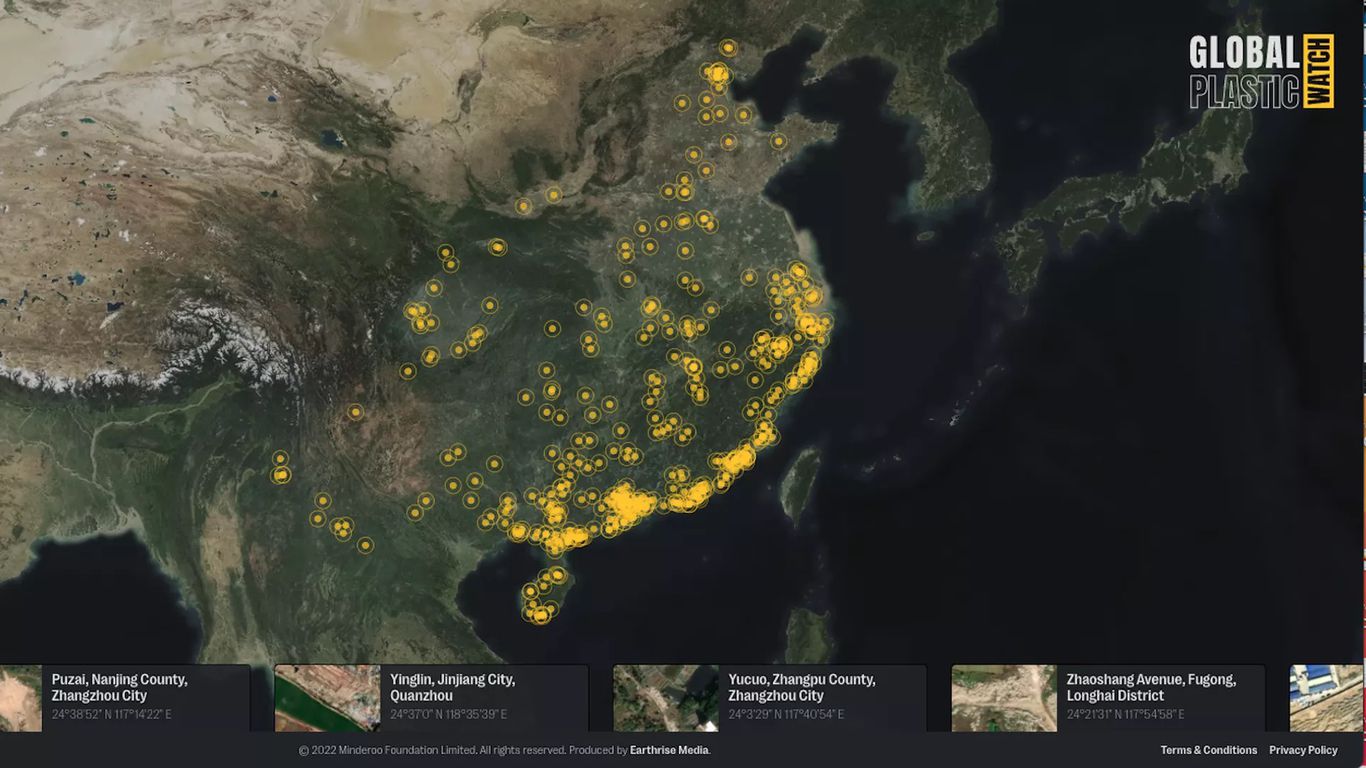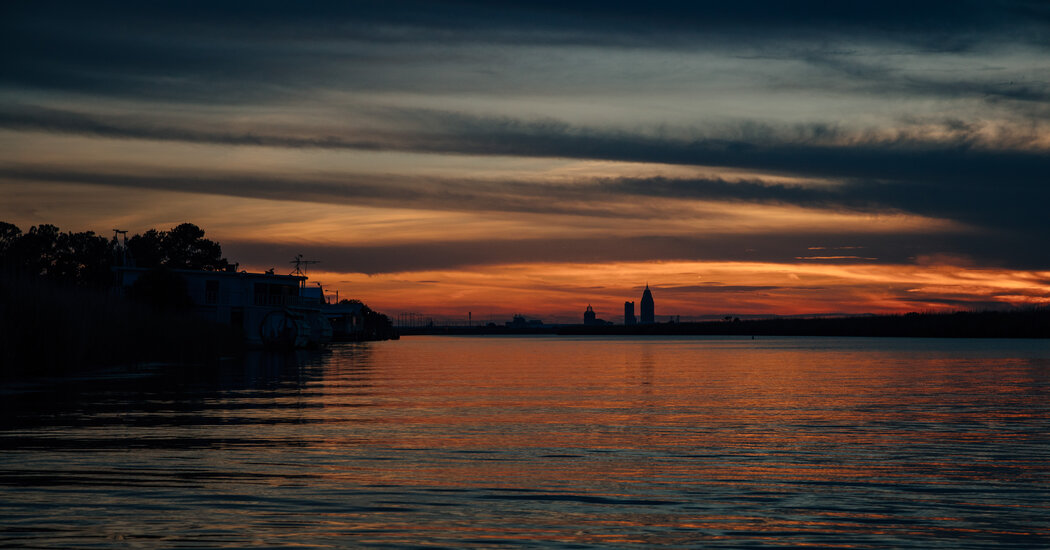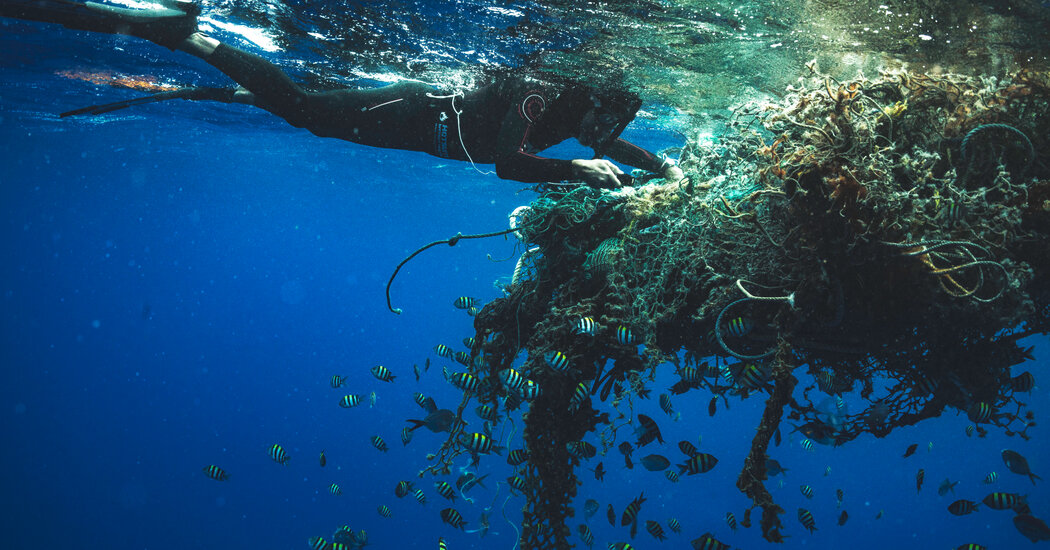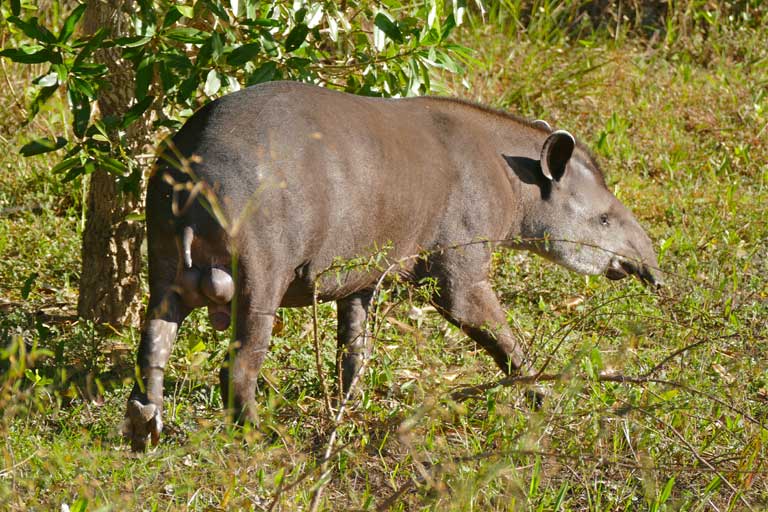NEW ORLEANS — On an overcast day in April, on the edge of Chalmette Battlefield, a few miles outside the city, Liz Marchio examined a pile of broken twigs and tree branches on the bank of the Mississippi River. “Usually I try to look — oh, there’s one,” said Marchio, a research associate for the Vertebrate Museum at Southeastern Louisiana University. She bent down to pick up something with a pinch of her thumb and forefinger and placed it in her palm for me to see.
The object in Marchio’s hand was small, round, and yellowish-white, about the size of a lentil. It looked like an egg, as if a fish or salamander or tadpole could come wriggling out of it. Marchio handed it to me and turned to flip over a tree branch floating in the water, where dozens more lay waiting underneath. She made a sound of disgust. We had come hunting, and we had quickly found our quarry: nurdles.
A nurdle is a bead of pure plastic. It is the basic building block of almost all plastic products, like some sort of synthetic ore; their creators call them “pre-production plastic pellets” or “resins.” Every year, trillions of nurdles are produced from natural gas or oil, shipped to factories around the world, and then melted and poured into molds that churn out water bottles and sewage pipes and steering wheels and the millions of other plastic products we use every day. You are almost certainly reading this story on a device that is part nurdle.
That is the ideal journey for a nurdle, but not all of them make their way safely to the end of a production line. As Marchio and I continued to make our way upriver toward New Orleans’ French Quarter, she began collecting nurdles in ziplock bags, marking in red Sharpie the date, location, number of beads collected, and the time taken to collect them.
Nurdles mix easily with the debris floating in the Mississippi River.
Neel Dhanesha/Vox
Liz Marchio collects nurdles beside a levee in New Orleans’s Lower Ninth Ward in April.
Neel Dhanesha/Vox
At one point, on the side of a levee outside the Lower Ninth Ward, she collected 113 nurdles in five minutes. This is not uncommon: An estimated 200,000 metric tons of nurdles make their way into oceans annually. The beads are extremely light, around 20 milligrams each. That means, under current conditions, approximately 10 trillion nurdles are projected to infiltrate marine ecosystems around the world each year.
Hundreds of fish species — including some eaten by humans — and at least 80 kinds of seabirds eat plastics. Researchers are concerned that animals that eat nurdles risk blocking their digestive tracts and starving to death. Just as concerning is what happens to the beads in the long term: Like most plastics, they do not biodegrade, but they do deteriorate over time, forming the second-largest source of ocean microplastics after tire dust. (A nurdle, being less than 5 millimeters around, is a microplastic from the moment of its creation, something also known as a primary microplastic.)
There’s much we still don’t know about how plastics can harm the bodies of humans and animals alike, but recent research has shown that microplastics can be found in the blood of as much as 80 percent of all adult humans, where they can potentially harm our cells. We may not eat the plastic beads ourselves, but nurdles seem to have a way of finding their way back to us.
In most of the United States, the federal and local government respond to nurdle spills big and small in the same way: by doing practically nothing. Nurdles are not classified as pollutants or hazardous materials, so the Coast Guard, which usually handles cleanups of oil or other toxic substances that enter waterways, bears no responsibility for them.
Likewise, most state governments have no rules in place around monitoring, preventing, or cleaning up nurdle spills; a spill is often an occasion of great confusion as local and state environmental agencies try to figure out who might be responsible for managing it. In the eyes of the federal government and every state except California, which began regulating marine plastics in 2007, nurdles are essentially invisible. For all official purposes, a nurdle that has escaped into the wild may as well have entered a black hole.
“Here in Louisiana, we’re making these nurdles and basically spilling oil, just in a different form,” said Mark Benfield, an oceanographer at Louisiana State University who studies microplastics, “And no one notices it, and no one seems to do anything about it.”
A nurdle often escapes from the plastic production process in mundane ways, slipping into drains at factories or spilling out of cargo containers while being transported by trains and ships. When nurdles are being loaded into trains, for example, they are often blown into rail cars using large hoses. The beads can leak around the edges of hoses at factories and out the sides of rail cars as they travel to distribution centers; Benfield and Marchio have both found nurdles lining the sides of tracks used by nurdle-carrying trains.
Sometimes, however, a large spill — often during transportation — will send millions or even billions of nurdles out into the world all at once, coating shorelines with deposits so thick they could be mistaken for banks of snow.
In May 2021, a container ship off the coast of Sri Lanka caught fire and sank, releasing an estimated 1,680 metric tons of nurdles in an incident the United Nations called “the single largest plastic spill on record.” About a year earlier, in August 2020, a storm hit a ship docked at the port of New Orleans, knocking a container filled with bags of nurdles into the Mississippi River. Hundreds of millions of beads escaped from their bags, coating local beaches in white plastic and floating down toward the Gulf of Mexico. They would remain long after the spill; Marchio pointed to a small dimple on the side of the first nurdle we found that identified it as a likely remnant of that spill.
“Big spills, like by ship containers and barge … that’s probably about once a year,” said Jace Tunnell, director of the University of Texas’ Mission-Aransas National Estuarine Research Reserve and founder of the Nurdle Patrol citizen science project, which asks contributors to count nurdles on their local beaches and uses the data to create a map of the pollution.
The map could easily be mistaken for a map of plastic production sites: The vast majority of red and purple dots, which correspond to particularly high levels of nurdles, appear in the petrochemical hubs of Texas and Louisiana. “What happens every single day — it’s a chronic problem — is the loss of pellets during on-loading and off-loading and during transportation,” Tunnell said.
Most plastic does not biodegrade, and a spilled nurdle does not simply disappear. Many wash up on shorelines, like the ones Marchio and I saw, where they easily blend in with the sand, shells, and assorted debris; if undisturbed, they will likely remain there for hundreds if not thousands of years.
A nurdle in the wild is a sneaky thing. Even before it starts breaking down, it is difficult to spot from afar, unlike the plastic bags or bottles we often associate with plastic pollution. It does not give off a heat signature or emit fumes, or create a sheen on the surface of water the way an oil spill might. What it does do is attract toxic pollutants. A nurdle floating down, say, the Mississippi River will absorb the pollutants riding alongside it while sloughing off the water, Benfield told me. It also provides a convenient home for phytoplankton, which will go on to attract zooplankton, which eat the phytoplankton and emit dimethyl sulfide — better known as the smell of the sea.
For many marine animals, the smell of the sea is the smell of food. Seabirds like albatrosses and petrels track dimethyl sulfide to locate patches of plankton from afar, swooping down to pluck their plankton-eating prey out of the water. A nurdle is the size and shape of a fish egg; its camouflage is nearly perfect after some time in the water, looking and smelling like easy pickings to fish, birds, turtles, and crustaceans alike.
Once eaten, nurdles can tangle a creature’s intestines or make it feel as if it is full, said Benfield. A 1992 EPA report found that at least 80 species of seabirds ate nurdles; Benfield said that number has since more than doubled. Plastics provide no nutrients to animals, but an animal that fills up on the beads will eat less food as a result, meaning it could starve to death without even knowing it was starving — especially if its digestive tract is too small to pass the nurdle. Photographs from the aftermath of the spill in Sri Lanka showed fish filled with the pellets, white plastic lining their insides.
A dead fish with a mouth full of nurdles washed ashore on a beach near Wellawatta in Colombo, Sri Lanka, after a container ship caught fire and sank near the Colombo harbor in May 2021.
Saman Abesiriwardana/Pacific Press/Shutterstock
A crab makes its way across a Sri Lankan beach covered in nurdles days after the container ship sank. There were 87 shipping containers of nurdles on board.
Eranga Jayawardena/AP
Plastics are endocrine disruptors, meaning they can stunt an animal’s development, and researchers are studying whether toxic pollutants can pass from a nurdle into an animal’s tissue and subsequently up the food chain. But measuring the full impact is difficult, in part because it’s difficult to know exactly what causes a marine animal to die in a world that is increasingly hostile to marine animals.
Preventing nurdle spills, say Tunnell and Benfield, would involve a number of deceptively simple changes. Companies can place containers in loading areas to catch any nurdles that fall during their loading and unloading from rail cars, install screens on storm drains to catch beads that wash away, or make the bags they’re packed into before being shipped out of a sturdier material so they’re less likely to split open. Workers can double-check valves on rail cars to make sure they’re fully tightened and vacuum up nurdles that spill onto factory floors.
Cleaning nurdles up after they’ve spread through an ecosystem is much harder, and no one wants to be responsible for it. The most promising solutions so far involve machines that are essentially vacuums with sieves that filter out sand while sucking up the nurdles. But they have yet to be widely tested, let alone adopted, and they’d be of little use cleaning up beads in the water.
Nurdles have a significant impact on the environment long before they are formed, as well. The vast majority of the plastics plants in the United States are located alongside communities of color, which are disproportionately impacted by industrial pollution. Those plants emit a toxic mixture of pollutants including ethylene oxide, styrene, and benzene; there are so many petrochemical plants located between Baton Rouge and New Orleans that the area has become known as “cancer alley.”
The tide may slowly be turning: Last year, residents of Louisiana’s majority-Black St. James Parish managed to delay the construction of a massive new plastics plant in their community, arguing that they’d suffer undue environmental harm, but the plants that are already in the area will continue to pump out both nurdles and the pollutants that come from making them.
As the world moves toward renewable energy and demand for fossil fuels is expected to peak in the near future, the oil and gas industry is increasingly shifting its business focus to plastic production. Plastic production is expected to triple by 2050 thanks to a fracking boom in the United States that makes natural gas extremely cheap to produce. That will lead to a rise in nurdle production. The question on researchers’ minds is where these beads will end up.
Mark Benfield scrunched up his face as he bent at the waist to examine the sand below him, placing his hands on his knees for support and looking a bit like a human-sized question mark. “This is hard on your back,” said Benfield. “A few decades from now we’ll all have nurdle-related back issues. Nurdle-osis, like scoliosis,” he joked.
We were standing on the beach at Elmer’s Island Wildlife Refuge, on the Gulf of Mexico a couple of hours’ drive south of New Orleans. The beach was empty aside from Benfield, myself, a couple of LSU students, and the occasional crab or seagull. This was the place where, in 2021, Benfield had found hundreds of nurdles nestled in the dunes, indicating a spill somewhere offshore. At first, Benfield thought they may have been the remnants of the 2020 spill in New Orleans. “But when we started to look at the shape and the weights, they were different,” Benfield said, “so there was some big spill of nurdles that we didn’t even know happened.”
Mark Benfield searches for nurdles at the Elmer’s Island Wildlife Refuge on the Gulf Coast of Louisiana. “Your eyes start to get a search image for them after a while,” Benfield said.
Neel Dhanesha/Vox
Mark Benfield holds a nurdle he found. Nurdles are usually smaller than 5 millimeters around, making them primary microplastics.
Neel Dhanesha/Vox
By the time Benfield and I went to Elmer’s Island, most of those nurdles had disappeared. Storms had eaten away at the dunes, and the wind likely pushed the beads inland to the marsh just north of where we were standing, where they would quickly settle into the mud and become unrecoverable. Within a few minutes of arriving, however, Benfield found one hidden amid a pile of sticks that had washed up on the sand. “This must be pretty recent,” he said; it had probably washed in with the tide a day or two ago, though there was no way to tell when it had spilled or where it had come from. Benfield produced a ziplock from a pocket of his cargo pants and dropped the nurdle inside.
The sound of shells crunching underneath our shoes accompanied us as we made our way up the beach; occasionally, Benfield would drop to his hands and knees to check whether he was looking at a nurdle or a shell. “I used to come to the beach to look for shark teeth,” Benfield said. “Now I’m looking for nurdles.”
That changed for Benfield after the 2020 spill in New Orleans. While he had been studying microplastics in the Gulf of Mexico since 2015 and found nurdles in the Mississippi River during previous research trips, he’d only ever pulled a handful out of the river at most; that August, they blanketed the banks. Benfield recruited Marchio, who worked for the Jean Lafitte National Historic Park at the time, to help document the spill, and together they spent days traveling to points along the Mississippi River, laying down square frames and counting tens of thousands of beads in the space of a single square foot.
As the local community learned about the spill through local news outlets and word of mouth, concerned residents organized cleanup efforts. Word got out that Benfield was interested in the nurdles, and people began sending him samples. At one point, Marchio found an entire bag of nurdles, practically intact, underneath a wharf in New Orleans. The name of the manufacturer, Dow Chemical, was still clearly stamped on the bag, along with a warning: “DO NOT DUMP INTO ANY SEWERS, ON THE GROUND, OR INTO ANY BODY OF WATER.”
Mark Benfield holds a nearly intact bag of nurdles recovered after a container full of nurdles fell off a ship docked in New Orleans in 2020.
Neel Dhanesha/Vox
While Benfield, Marchio, and the volunteers busied themselves with trying to document and clean up the spill, state and federal agencies spent weeks trying to decide who, if anyone, ought to be responsible for oversight of the spill and any potential cleanup.
While the Coast Guard usually takes responsibility for cleanups of oil and toxic substances that spill into waterways, it has no responsibility for nontoxic spills. Because nurdles aren’t deemed hazardous to human health under federal or Louisiana state law, a court had to decide which agency, if any, was responsible for cleaning up the spill, said Gregory Langley, a spokesperson for the Louisiana Department of Environmental Quality (DEQ). “The problem with court action is it’s not instantaneous,” Langley said.
The Mississippi River, of course, was not beholden to the courts; while the agencies waited and debated whose job it was to clean up the nurdles, the current carried them downriver. “If you lose something in the river,” said Langley, “it’s gone.”
About three weeks after the spill, the ship’s operator paid for a small crew of men with booms, leaf blowers, and butterfly nets to clean up a small section of the river. The voluntary cleanup, the DEQ reasoned, rendered waiting for the court a moot point; no determination was made about which agency, if any, would have been responsible for the spill.
That cleanup crew was mostly for show, Benfield told me, and most of the nurdles had already disappeared, carried downriver by the current and blown away by the wind. The DEQ still doesn’t know who would be responsible for cleaning up such a spill in the future. “All of that is subject to court action,” Langley told me. So the DEQ would still have to wait for a court decision in the event of a future spill.
Benfield and Marchio have since become the de facto Louisiana outpost of a countrywide effort to document, map, and, eventually (they hope) stop nurdle spills. In the aftermath of the 2020 spill, Benfield turned his lab in LSU’s Baton Rouge campus into a sort of evidence room. When I visited, jars of nurdles lined the countertop by a sink; dozens more were packed into boxes, ready to be shipped to Jace Tunnell in Texas so he could include them in teaching kits he sends to schools around the country. The bag of nurdles Marchio found underneath the wharf in New Orleans sat in one corner, next to a bucket filled with a mixture of sand, twigs, and nurdles brought in by a well-meaning local who helped with the cleanup in 2020.
When Benfield finds new nurdles, he analyzes them under a spectrometer to see what they are made of; he hopes to eventually build a database of nurdles so that they can be traced back to their origin. In an ideal world, he’d receive samples of nurdles from plastics manufacturers that could make that sort of tracing easier, but he doubts they would be open to the idea; there’s no business case for accountability, he reasons.
Benfield analyzes a nurdle found at the Elmer’s Island Wildlife Refuge using a spectrometer in his lab at Louisiana State University. He hopes to eventually build a database of nurdles that can be used to trace them to their source.
Neel Dhanesha/Vox
“It’s ridiculous. If I went to the river and tossed in hundreds of plastic bags, I’d be in trouble,” Benfield said. Under Louisiana law, he would likely be fined somewhere between $500 and $1,000 for littering, at the least, and have to serve a few hours in a litter abatement program. “But because (the nurdles) are so small,” he continued, “the companies get away with it.”
Being the documenter of plastic pellets is thankless work. There’s little funding for researching them, and Benfield, Marchio, and Tunnell often speak with the air of people resigned to the seemingly quixotic quest of tilting at nurdles. “Nurdles infiltrate your brain,” Marchio said to me once. “I have to remember that my role is monitoring, not cleaning. If I try to clean, I’ll just get frustrated.”
So what does doing something about nurdles look like?
The plastics industry’s stance on plastic pollution at large has long been that recycling needs to be improved. More responsible consumer behavior and waste-management practices, the industry line goes, will bring post-consumer plastics back to manufacturers that can reuse them. But a nurdle almost never reaches a consumer’s hands in its base form, and asking consumers to solve the nurdle problem through recycling would be akin to asking drivers to clean up an oil spill by conserving the fuel in their cars. Unlike a finished plastic product, the solution to nurdle spills, like nurdles themselves, will have to be found somewhere in the plastic production process.
For a brief moment a few years ago, it seemed as though the answer could come from the courts. In 2019, a federal judge in Texas approved a $50 million settlement in a case brought by Diane Wilson, a retired shrimper, which alleged that a plant run by the Taiwanese plastics giant Formosa Plastics had violated its permits by illegally discharging nurdles into the water in and around Lavaca Bay, on the Gulf Coast in Calhoun County, Texas.
The settlement, which was the largest of its kind in American history to result from a civil environmental lawsuit, included a consent decree that committed Formosa to “zero discharge” standards. In other words, the company’s plant at Lavaca Bay’s Point Comfort had to stop releasing pellets into the water or risk fines of up to $10,000 for each violation in the first year, increasing annually to a maximum of $54,000 per violation.
Formosa isn’t quite keeping its end of the bargain. Since it began operations in June 2021, said Wilson, a wastewater monitoring facility set up to keep tabs on Formosa’s pellet discharge has logged at least 239 violations, for fines totaling $5.3 million and counting. “The implementing of this consent decree is the hardest thing we have ever done,” said Wilson, who at 73 years old has been an environmental activist for more than 30 years. “You’ve got to be on them all the time. Most of my life is almost full-time Formosa.”
For Formosa, which is the sixth-largest chemical company in the world with sales of $27.7 billion in 2020, a $5.3 million fine is “almost like the cost of doing business,” Tunnell said. At least for now, it seems it’s cheaper to simply keep racking up those small fines over time than to make any potential large investments that would be needed to stop the nurdles from spilling in the first place.
In the meantime, Wilson told me, fishers in Lavaca Bay continue to pull up fish with nurdles in their guts; oyster fishers have found the beads nestled in their catch like pearls. The area is home to a mercury superfund site — an EPA designation for contaminated industrial areas that receive funding for cleanup efforts — that was closed to fishing for decades due to the threat of mercury poisoning. Mercury has already devastated local marine life; now, Wilson says researchers and activists are concerned the nurdles may absorb the mercury and become vectors that can carry the mercury beyond Lavaca Bay. “People just ignore it,” Wilson said.
The Formosa Plastics plant in Point Comfort, Texas, south of Houston, in November 2021. It set up shop here in 1983, near the waters where shrimpers used to catch shrimp in abundance.
Mark Felix/AFP via Getty Images
Former shrimper Diane Wilson outside the Formosa Plastics plant in Point Comfort, Texas, in November 2021. Wilson has been documenting alleged pollution by Formosa for years.
Mark Felix/AFP via Getty Images
While Wilson’s lawsuit was a remarkable victory, it was also an indicator of the difficulty of addressing nurdle pollution piecemeal. Wilson and her collaborators spent years collecting thousands of beads from around the area — including one discharge site in the middle of the water, which Wilson had to kayak out to — and it was only through amassing a mountain of evidence that she was able to convince a judge that Formosa’s Point Comfort plant was responsible for the beads that were washing up in the area. Attributing nurdles to a particular source is difficult, and repeating the feat would require a similar effort for every nurdle production plant in the country.
“I think the best place to start is to take a small step backward and recognize we have laws on the books already that are meant to regulate pollution and emissions from manufacturing and production facilities,” said Anja Brandon, US plastics policy analyst at the Ocean Conservancy, a nonprofit that works to protect oceans and marine life. “Namely in this instance, the Clean Water Act, kind of our bedrock environmental law.”
The Clean Water Act passed in 1972 after the Cuyahoga River in Cleveland, Ohio, caught fire in 1969, drawing national attention to the country’s polluted waterways. Today, the act regulates the discharge of various pollutants into waters around the country; it’s a major reason why many of the nation’s rivers are cleaner now than they were 50 years ago.
“These laws haven’t been updated to meet the needs of the moment,” said Brandon. In most of the country, she explained, “plastic nurdles have essentially gotten off scot free because they have yet to be classified or specifically labeled as a pollutant.” The rare exception is California, which in 2007 became the first and so far only state to pass a law classifying nurdles as pollutants to be regulated under the Clean Water Act, citing their contribution to litter on beaches and the possibility that they could be mistaken for food by marine animals.
Lawmakers in Texas and South Carolina have introduced similar legislation, though both bills seem stuck. The Texas bill, introduced in the House by representative Todd Hunter last year, never moved forward, while the South Carolina bill passed the state senate in 2021 but was recently shelved in the House.
Closing the nurdle loophole, says Brandon, would require classifying nurdles as a pollutant under the Clean Water Act at the federal level. Lawmakers have shown some support for this approach: In 2020, then-Sen. Tom Udall (D-NM) introduced the Break Free From Plastics Pollution Act, which would have put in place wide-ranging regulations on plastics and recycling.
Identical bills were reintroduced in the House by Alan Lowenthal (D-CA) and in the Senate by Jeff Merkley (D-OR) in March 2021, but neither bill has moved beyond committee. In April 2021, Sen. Dick Durbin (D-IL) introduced the much shorter and more tightly focused Plastic Pellet Free Waters Act, which would give the EPA regulatory control over nurdles through the Clean Water Act; that bill has also been stalled.
The plastics industry is opposed to both bills. “We do not think that plastics belong in the environment. They belong in the economy,” said Joshua Baca, vice president of the plastics division at the American Chemistry Council, a major plastics industry trade group. That said, he continued, “The Break Free From Plastics Pollution Act is really a bad piece of legislation. It has a very nice title. But it can be very misleading to the average person.”
Legislation like the Break Free From Plastics Pollution Act or the Plastic Pellet Free Waters Act, Baca argued, are disguised attempts to simply shut down plastic manufacturing in the US more broadly. “We generally think that the best approach here is to think about this holistically in a way that looks at loss across the entire value chain and puts in place best practices to avoid the loss within the environment,” he continued.
Baca pointed to Operation Clean Sweep, or OCS, a voluntary program run by the American Chemistry Council and the Plastics Industry Association that’s meant to curb nurdle leaks and spills but maintains no oversight mechanism and imposes no penalty for failure to comply.
“Many of our companies are inserting state-of-the-art technology within their facilities … to ensure that they limit the loss of pellets going on,” Baca said. When I asked Baca for more information, he demurred, citing the possible use of proprietary technology.
Formosa Plastics, the subject of Diane Wilson’s lawsuit, is not only a participant in Operation Clean Sweep but also a member of OCS blue, a “data-driven VIP member offering” of Operation Clean Sweep that “enhances the commitment to management, measurement, and reporting of unrecovered plastic releases into the environment from resin handling facilities.” Members receive plaques commemorating their enrollment.
Nurdles seen under a microscope. The nurdle in the middle has begun degrading through exposure to the elements; the white ones nearby are from recent spills and haven’t been in the environment long enough to start degrading. It is estimated nurdles can stay in the environment for hundreds or even thousands of years.
Neel Dhanesha/Vox
“I think they have a lot of good practices that ought to be mandatory, but they’re voluntary,” said Tunnell. “That obviously does not work. There needs to be accountability.” One way to create that accountability, Tunnell told me, would be to classify plastic pellets as hazardous substances outright, which would not only bring much tighter scrutiny to the production process but also give the Coast Guard the authority to coordinate and perform cleanups whenever a spill occurs. This is something like the nuclear option for nurdles, and would no doubt be the subject of stiff opposition from the plastics industry if it ever becomes a matter of debate.
For Tunnell, the stakes are existential. A failure to stop nurdles from spilling would be like giving up on the future of our world. “At the end of the day, it comes down to the next generation,” Tunnell said. “These plastic pellets will be around for hundreds of years. It’s not like they dissolve. They’re just accumulating and accumulating, and even if you’re in high school right now, your great-grandkids will see the same pellets on the beach. So I think we owe it to my great-grandkids and their great-grandkids to do something about this now.”



